
Boost your rankings and attract more customers through our SEO expertise.

Roll up, roll up, Google’s got some fresh tools to change targeting and measurement once again! Google’s Marketing Keynote for 2017, dubbed proudly by Google as “Marketing Next”, is Google’s annual summit to show off a lot of fancy new features and tools that will be rolling out over Google’s favourite time period, “the coming months”. While not all of the new announcements are as dramatic or even new as Google would like you to think, the overall theme of the event and key soundbites are interesting in themselves, as they represent the way Google see the industry evolving over the new 12 months. In this blog, we’ll look at some of the key takeaways that you need to know about and will shape some of your marketing strategies over the next 12 months – as despite what you may think of Google at times, they generally have a good pulse on what’s coming up and good tech worth testing. After all, they’re the world’s most successful search company. ** Some the notes/opinions below may change once we’re able to flesh out announcements with more detail. Think of the keynote as a Google election manifesto…**
Google are the masters at setting the scene and giving their changes context. Below are some of the key figures from this year’s event:
Wrap all that together and you can see that without a solid mobile platform and experience, you’re pushing water uphill. Before even looking into marketing strategies, checking the health of your mobile platform should be a key consideration for all businesses. The Test My Site tool, again handily created by Google, is great for a quick overview on how you’re mobile site is shaping up.
Using the rule of three for presentations, Google showcased new features, advancements and announcements for some of their key platforms. We’ll look at the highlights for each one and how they can be applied to drive better results.
Building on the theme of mobile, Google seems to be giving Google AMP compatible pages an advantage in some of their results and initiatives. AMP pages are part of landing page search, display and shopping betas, giving pages priority on select terms and placements. Look at the searches for “best antiseptic mouthwash” (Google’s example, nothing personal) versus “buy antiseptic mouthwash” to see how “Top Rated By Google” could become more prominent over the next 12 months.  With mobile and more data connections, Google are also improving their location options with location extensions and store visit data based on YouTube campaigns. Store sales measurement is also getting an increased focus through two different approaches:
With mobile and more data connections, Google are also improving their location options with location extensions and store visit data based on YouTube campaigns. Store sales measurement is also getting an increased focus through two different approaches:
This is a powerful development and a fantastic one for high street brands.
Theme: Better, Brand-New, Broader AdWords continues to evolve beyond an intent targeting platform by giving more consideration to audiences and advanced targeting options. Google has recognised they need to offer advertisers new ways of targeting to reclaim ad dollars lost to other networks and techniques, particularly programmatic, by giving more access and more integrated options through their own platforms. It was interesting that Google stressed the privacy features and controls they have in place before unveiling how they’ll give marketers greater ability to join up strategies and target based on more data… A big focus for Google at the moment is machine learning and intent to help advertisers reach their desired audiences better than before. More data will be analysed across platforms, devices and in real time with the platforms themselves becoming more integrated to allow smarter bidding. For example, if a user has viewed your YouTube video or subscribed to your channel, there is now the ability to target them within the search results. That means if you promote a trailer or your new Christmas ad, you can take this audience and apply it to generic search campaigns which may not normally drive enough conversions to make the CPA affordable. You could also present your branded traffic with a message that builds on the content of the video. Coupled with Similar Audiences for Search, Google is trying to allowing advertisers to achieve better ROIs beyond longtail and brand bidding by making the keywords with huge search volume more appealing with the recent exact match changes also “helping” advertisers in this direction. New audience targeting options in terms of Life Events and Customer Patterns seem like an attempt to take on Facebook by integrating more user data into audience target options. Opening up this targeting via Google will allow advertisers to get creative with strategies (bought a new house, perhaps time for a new TV; graduated from uni, time to get a job or take a gap year holiday) if the audience quality is high enough. This is only being rolled out to Gmail ads to start with, so maybe Google already has quality concerns. More interestingly, in-market audiences are also coming to search, which again presents new opportunity for targeting a new set of keywords or retesting previously poor performing terms. With the amount of online real estate Google has, they know that someone who is looking to buy a car doesn’t always just Google “buy the best car”. They watch videos, read reviews and other related content before perhaps converting on brand. Depending on the detail of how these are structured, they again could be a good way to target more terms beyond the niche of exact intent. Our experience of these audience on display has been mixed but improving, and with the amount of data Google has, this will be very powerful if they get this right.
Themes: Attribution, Attribution, Reach & Frequency Last-click attribution has been a problem for marketers for years. The world is so integrated that this approach really isn’t the best solution, but it is sometimes still used nonetheless. Why? It’s comforting, it’s what many people have always used, and it makes sense to key stakeholders beyond the marketing team. To counter this, Google has ambitiously claimed to have “solved the attribution problem”. Big words! By rolling out a system called Google Attribution (nothing like naming the product after yourself to make it sound grand), the ability for data driven attribution and modelling is being made easier and more integrated across Google’s properties. By taking into account multiple channels, touchpoints and devices, as well as presenting the same attribution model across AdWords, Google Analytics and DoubleClick Search alongside last click attribution reporting should make it easier for brands and in turn advertisers to progress beyond last click. As always though with attribution, beliefs and who to trust play a more important role than data until results are proven. This is in beta and worth testing to see what difference it can make to performance.
Themes: Smarter, Faster, Test As well as changes to make the AdWords platform itself faster, Google is integrating AdWords and Optimize to make A/B testing (CRO) functionality a little bit slicker. Landing page tests can be created at campaign, adgroup or even keyword level within AdWords to help drive more conversions from traffic you’re already generating. While it has some limitations, Optimize is a great way to begin A/B testing without having to rely on developers. Starting with small tests such as changing the image or header tag on a landing page in an agile way will allow marketers to build the business case for CRO to be a key part of all ongoing strategies. The ability to create new in-market audiences based on keywords seems interesting and could be a slight variation on custom audiences which are of interest or URL-based, but we need more detail here before getting excited. Custom audiences have proven to be a strong addition to our display campaigns in the past, so we’re quite positive about this development, as well. There are more tools and functionality that are being rolled out across Adwords and DoubleClick, such as automated audience builds based on objectives, but these are more niche, aimed at campaign managers rather than brands – or they require budgets of a certain size. We’ll be happy to discuss these in depth if you wish to you know more. 
Subscribe to our monthly newsletter.
Google’s Marketing Keynote are always ideal-rich and detail light, but there are some interesting announcements which create fresh opportunities for advertisers. Following Google’s rule of three, I would say the top three highlights are these:
Finally, if the above sounds too distant to you or smoke and mirrors, the following statement can be just as powerful as changes in tools, platforms or targeting. You can view the full keynote presentation on YouTube. If you’re not challenging yourself and instead run the same old activity week in week out, you’re going to be left behind. It won’t happen overnight, and core strategies of search should still be given enough focus. If you’re not pushing the boundaries, however, you are missing out on conversions and growth. And if that still doesn’t prompt you to act, isn’t it just more fun and interesting to try some new things?!
Want to know more about how Google affects your business? Get in touch with DAC to arrange a meeting!
Subscribe to our monthly newsletter.